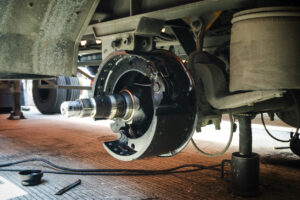
From August 24-30, 2025, the Commercial Vehicle Safety Alliance (CVSA) will conduct its annual Brake Safety Week. During this time, inspectors across the U.S., Canada, and Mexico will focus on brake system inspections, with this year’s emphasis on brake drums and rotors.
For owner-operators, this week is more than just another enforcement initiative; it is a chance to ensure your truck is compliant, safe, and road-ready. Here is what you need to know to stay ahead.
What is Brake Safety Week?
Brake Safety Week is part of CVSA’s Operation Airbrake Program. Its purpose is to identify unsafe commercial vehicles, reduce accidents caused by brake failures, and educate drivers and fleets about preventive maintenance.
In 2024, inspectors conducted more than 16,700 inspections, and nearly 13% of trucks were placed out of service (OOS) for brake-related violations. These numbers show just how important it is for drivers to prepare in advance.
Why the Focus on Drums and Rotors?
Each year, CVSA highlights a specific brake component. In 2025, the spotlight is on drums and rotors because:
- Cracks, deep grooves, or missing chunks can weaken braking ability.
- Heavy rust-exposed vents can indicate poor maintenance and unsafe operation.
- Damaged drums and rotos increase the risk of accidents and costly violations.
Inspectors will look closely at these components to determine whether trucks meet safety standards.
What Inspectors Will Be Looking For
During roadside inspections, expect inspectors to evaluate:
- Drums and rotors for cracks, grooves, or wear and tear.
- Brake linings/pads are subject to contamination, cracks, or excessive wear and tear.
- Air systems are designed to detect leaks, damaged hoses, and faulty slack adjusters.
- Pushrods are adjusted to confirm that the brakes are within legal specifications.
- Brake component condition, including chambers, pins, and bolts.
Any violation in these areas can lead to an OOS order, fines, or downtime.
Pre-Inspection Checklist for Owner-Operators
To prepare, CVSA recommends these eight tips for drum and rotor maintenance:
- Inspect brake drums and rotors during every pre- and post-trip check.
- Look for cracks or missing material on the surfaces.
- Watch for outer cracks or broken sections.
- Remove heavy rust that could impact performance.
- Check for deep grooves that signal wear and tear.
- Replace rotos with exposed vents.
- Follow the manufacturer’s repair guidelines.
- Document issues on FVIRs and notify your carrier.
How to Stay Ahead of Inspections
Preparation is the best way to avoid surprises. Here’s how to stay ready:
- Inspect early and often: Don’t wait until inspection week; address problems now.
- Keep documentation handy: Have up-to-date DVIRs and maintenance records ready to show.
- Train your team: If you work with drivers or mechanics, ensure they understand what inspectors look for.
- Use proper parts: Always replace with certified components to avoid repetitive issues.
- Stay proactive: Regular checks not only help with compliance but also improve safety and reduce downtime.
Why Brake Safety Week Matters
At its core, Brake Safety Week is about more than avoiding violations. For owner-operators, it is about:
- Protecting lives on the road.
- Reducing costly repairs and downtime.
- Demonstrating professionalism and compliance.
- Building trust with brokers, shippers, and carriers.
Brake Safety Week (August 24-30, 2025) is quickly approaching. By inspecting brake drums and rotors, maintaining accurate records, and addressing issues ahead of time, owner-operators can avoid violations, protect their business, and keep the roads safe for everyone.
Staying proactive not only helps you pass inspections but also reinforces your reputation as a safe, reliable professional in the trucking industry.

